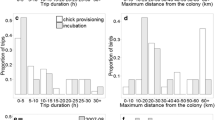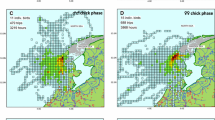Abstract
In temperate regions, winter presents animals with a number of challenges including depressed food abundance, increased daily energy requirements, higher frequency of extreme weather events and shortened day length. Overcoming these constraints is critical for overwintering survival and scheduling of future breeding of long-lived species and is likely to be state dependent, associated with intrinsic abilities such as food acquisition rates. We examined the relationship between environmental and intrinsic factors on overwintering foraging and subsequent breeding phenology of the European shag Phalacrocorax aristotelis, a diurnal marine predator. We tested a range of hypotheses relating to overwintering foraging time and location. We found that individuals greatly increased their foraging time in winter to a peak of more than 90% of available daylight at the winter solstice. The seasonal patterns of foraging time appear to be driven by a combination of light levels and weather conditions and may be linked to the availability of the shag's principal prey, the lesser sandeel Ammodytes marinus. There was no evidence that shags dispersed south in winter to increase potential foraging time. Foraging time decreased after the winter solstice and, crucially, was correlated with subsequent breeding phenology, such that individuals that spent less time foraging in February bred earlier. The relationship was much stronger in females than males, in line with their more direct control of timing of breeding. Our results demonstrate that pre-breeding intrinsic foraging ability is critical in determining breeding phenology.




Similar content being viewed by others
References
Aebischer NJ (1986) Retrospective investigation of an ecological disaster in the shag, Phalacrocorax aristotelis—a general method based on long-term marking. J Anim Ecol 55:613–629
Aebischer NJ (1993) Immediate and delayed effects of a gale in late spring on the breeding of the shag Phalacrocorax aristotelis. Ibis 135:225–232
Aebischer NJ, Wanless S (1992) Relationships between colony size, adult non-breeding and environmental conditions for shags Phalacrocorax aristotelis on the Isle of May, Scotland. Bird Study 39:43–52
Afanasyev V (2004) A miniature daylight level and activity data recorder for tracking animals over long periods. Mem Natl Inst Polar Res 58:227–233
Bradshaw CJA, Hindell MA, Sumner MD, Michael KJ (2004) Loyalty pays: potential life history consequences of fidelity to marine foraging regions by southern elephant seals. Anim Behav 68:1349–1360
Croxall JP, Silk JRD, Phillips RA, Afanasyev V, Briggs DR (2005) Global circumnavigations: tracking year-round ranges of nonbreeding albatrosses. Science 307:249–250
Daunt F, Wanless S, Harris MP, Monaghan P (1999) Experimental evidence that age-specific reproductive success is independent of environmental effects. Proc R Soc Lond B Biol Sci 266:1489–1493
Daunt F, Monaghan P, Wanless S, Harris MP, Griffiths R (2001) Sons and daughters: age-specific differences in parental rearing capacities. Funct Ecol 15:211–216
Daunt F, Wanless S, Peters G, Benvenuti S, Sharples J, Grémillet D, Scott B (in press) Impacts of oceanography on the foraging dynamics of seabirds in the North Sea. In: Boyd IL, Wanless S, Camphuysen CJ (eds) Top predators in marine ecosystems: their role in monitoring and management. Cambridge University Press, Cambridge
DeLong RL, Stewart BS, Hill RD (1992) Documenting migrations of northern elephant seals using day length. Mar Mamm Sci 8:155–159
Elston DA, Horgan GW, Hunter EA (2001) Introduction to REML for scientists. BioSS, Edinburgh
Frederiksen M, Harris MP, Daunt F, Rothery P, Wanless S (2004) Scale-dependent climate signals drive breeding phenology of three seabird species. Glob Change Biol 10:1214–1221
Goss-Custard JD, Jenyon RA, Jones RE, Newbery PE, Williams RLB (1977) The ecology of the Wash II. Seasonal variation in the feeding conditions of wading birds (Charadrii). J Appl Ecol 14:701–719
Grémillet D, Tuschy I, Kierspel M (1998) Body temperature and insulation in diving great cormorants and European shags. Funct Ecol 12:386–394
Grémillet D, Wilson RP, Wanless S, Peters G (1999) A tropical bird in the arctic. Mar Ecol Prog Ser 188:305–309
Harris MP, Swann B (2002) Shag Phalacrocorax aristotelis. In: Wernham C, Toms M, Marchant J, Clark J, Siriwardena G, Baillie S (eds) Migration atlas. T. & A.D. Poyser, London, pp 139–142
Harris MP, Wanless S (1991) The importance of the lesser sandeel Ammodytes marinus in the diet of the shag Phalacrocorax aristotelis. Ornis Scand 22:375–382
Harris MP, Wanless S (1996) Differential responses of guillemot Uria aalge and shag Phalacrocorax aristotelis to a late winter wreck. Bird Study 43:220–230
Harris MP, Buckland ST, Russell SM, Wanless S (1994) Year-related and age-related variation in the survival of adult European shags over a 24-year period. Condor 96:600–605
Hays GC, Houghton JDR, Isaacs C, King RS, Lloyd C, Lovell P (2004) First records of oceanic dive profiles for leatherback turtles, Dermochelys coriacea, indicate behavioural plasticity associated with long-distance migration. Anim Behav 67:733–743
Hepp GR (1985) Effects of environmental parameters on the foraging behavior of three species of wintering dabbling ducks (Anatini). Can J Zool 63:289–294
Hill RA, Barrett L, Gaynor D, Weingrill T, Dixon P, Payne H, Henzi SP (2003) Day length, latitude and behavioural (in)flexibility in baboons (Papio cynocephalus ursinus). Behav Ecol Sociobiol 53:278–286
Lewis S, Benvenuti S, Dall'Antonia L, Griffiths R, Money L, Sherratt TN, Wanless S, Hamer KC (2002) Sex-specific foraging behaviour in a monomorphic seabird. Proc R Soc Lond B Biol Sci 269:1687–1693
Lewis S, Schreiber EA, Daunt F, Schenk GA, Wanless S, Hamer KC (2004) Flexible foraging patterns under different time constraints in tropical boobies. Anim Behav 68:1331–1337
Marquiss M, Duncan K (1994) Diurnal activity patterns of goosanders Mergus merganser on a Scottish river system. Wildfowl 45:209–221
McNamara JM, Houston AI (1996) State-dependent life histories. Nature 380:215–221
Milner JM, Elston DA, Albon SD (1999) Estimating the contributions of population density and climatic fluctuations to interannual variation in survival of Soay sheep. J Anim Ecol 68:1235–1247
Newton I (1998) Population limitation in birds. Academic, London
Patterson HD, Thompson R (1971) Recovery of inter-block information when block sizes are unequal. Biometrika 58:545–554
Phillips RA, Silk JRD, Croxall JP, Afanasyev V, Briggs DR (2004) Accuracy of geolocation estimates for flying seabirds. Mar Ecol Prog Ser 266:265–272
Potts GR, Coulson JC, Deans IR (1980) Population dynamics and breeding success of the shag, Phalacrocorax aristotelis, on the Farne Islands, Northumberland. J Anim Ecol 49:465–484
Robertson DR, Petersen CW, Brawn JD (1990) Lunar reproductive cycles of benthic-brooding reef fishes: reflections of larval biology or adult biology. Ecol Monogr 60:311–329
Snow B (1960) The breeding biology of the shag Phalacrocorax aristotelis on the island of Lundy, Bristol Channel. Ibis 102:554–575
Stearns SC (1992) The evolution of life histories. Oxford University Press, Oxford
Wanless S, Harris MP (1997) The shag. BWP Updat 1:1–13
Wanless S, Finney SK, Harris MP, McCafferty DJ (1999) Effect of the diel light cycle on the diving behaviour of two bottom feeding marine birds: the blue-eyed shag Phalacrocorax atriceps and the European shag P. aristotelis. Mar Ecol Prog Ser 188:219–224
Winslade P (1974) Behavioural studies on the lesser sandeel Ammodytes marinus (Raitt) II. The effect of light intensity on activity. J Fish Biol 6:577–586
Wright PJ, Bailey MC (1996) Timing of hatching in Ammodytes marinus from Shetland waters and its significance to early growth and survivorship. Mar Biol 126:143–152
Acknowledgements
We thank Dirk Briggs, John Croxall and Mike Harris for support throughout the project. We are grateful to Debbie Russell for help in the field, and David Elston for statistical advice. We thank Sue Lewis and Morten Frederiksen for useful discussions and valuable comments on the manuscript, and SNH for access to the Isle of May. The work complies with the current laws of the country in which it was performed.
Author information
Authors and Affiliations
Corresponding author
Additional information
Communicated by Communicated by M. Leonard
Rights and permissions
About this article
Cite this article
Daunt, F., Afanasyev, V., Silk, J.R.D. et al. Extrinsic and intrinsic determinants of winter foraging and breeding phenology in a temperate seabird. Behav Ecol Sociobiol 59, 381–388 (2006). https://doi.org/10.1007/s00265-005-0061-4
Received:
Revised:
Accepted:
Published:
Issue Date:
DOI: https://doi.org/10.1007/s00265-005-0061-4




